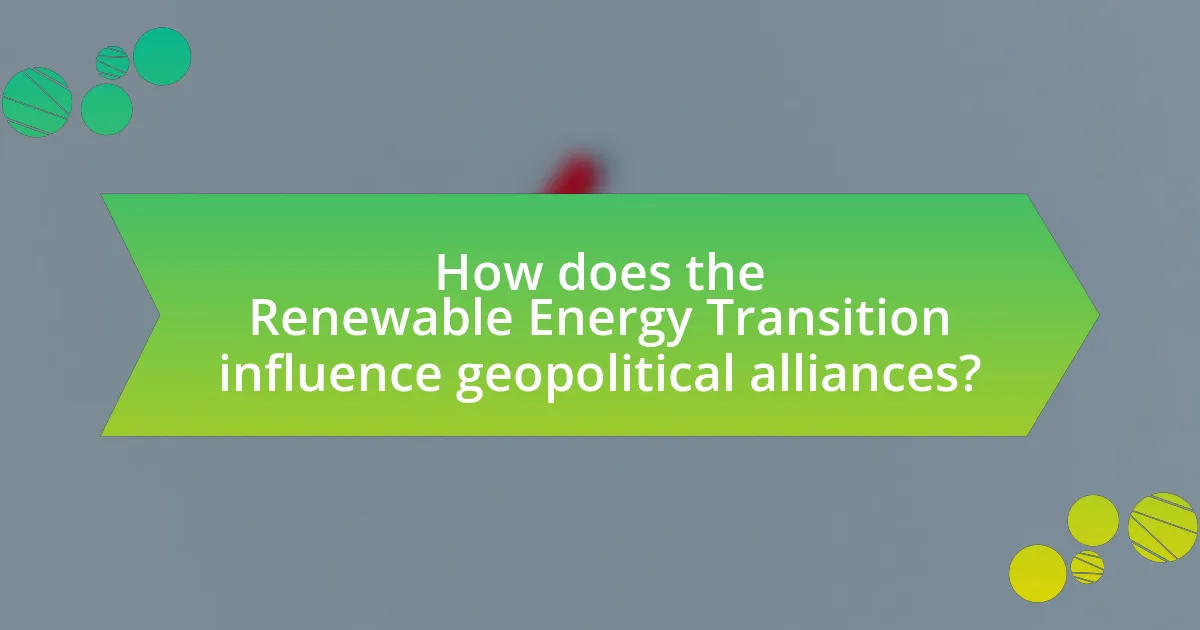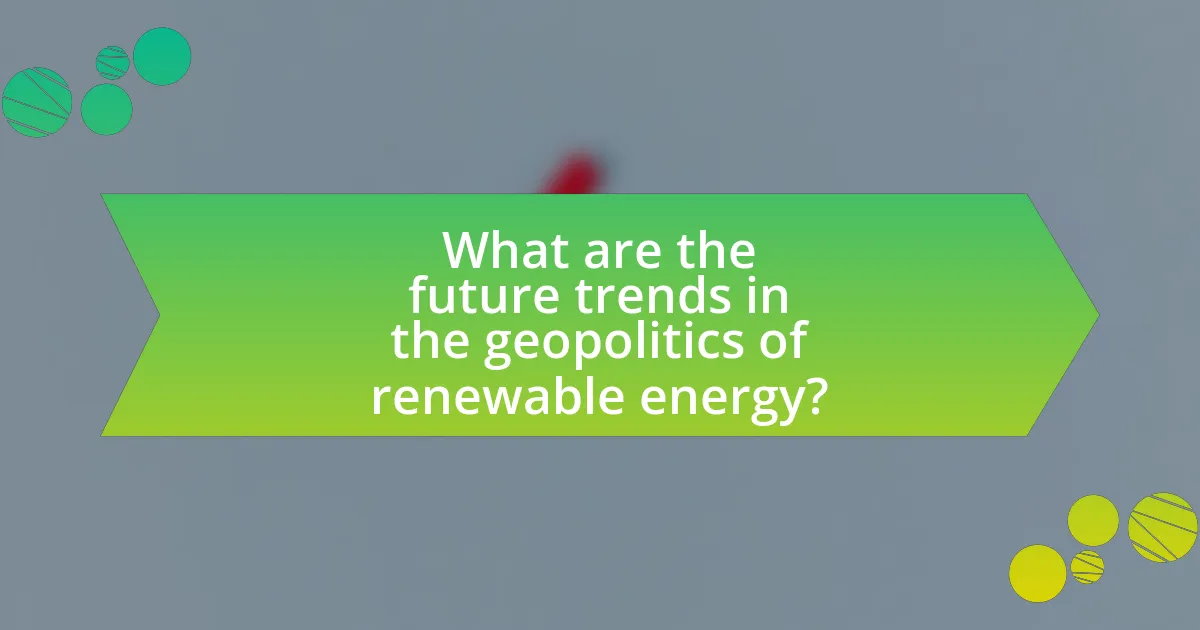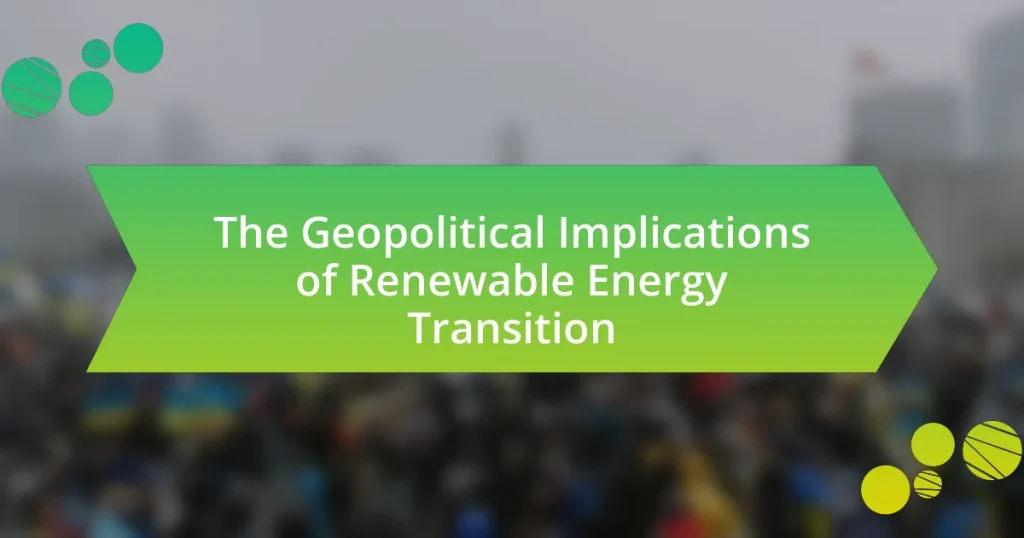The article examines the geopolitical implications of the renewable energy transition, highlighting shifts in global power dynamics, energy independence, and international relations. It discusses how countries investing in renewable technologies, such as solar and wind, can enhance their energy security and reduce reliance on fossil fuel imports, thereby altering traditional alliances and rivalries. Key players in this transition include Germany, China, and the United States, which are setting benchmarks in renewable energy adoption. The article also addresses the economic impacts, security implications, and the formation of new geopolitical alliances driven by competition for critical minerals essential for renewable technologies. Additionally, it explores future trends and strategies for nations to navigate the evolving energy landscape.

What are the Geopolitical Implications of Renewable Energy Transition?
The geopolitical implications of renewable energy transition include shifts in global power dynamics, energy independence, and changes in international relations. As countries invest in renewable technologies, they reduce reliance on fossil fuel imports, which historically have been a source of geopolitical tension. For instance, the International Energy Agency reported that nations transitioning to renewables can enhance their energy security and reduce vulnerability to oil price fluctuations and supply disruptions. Additionally, countries rich in renewable resources, such as solar and wind, may gain strategic advantages, altering traditional alliances and rivalries. The transition also fosters competition for critical minerals essential for renewable technologies, further influencing geopolitical landscapes.
How does the shift to renewable energy affect global power dynamics?
The shift to renewable energy significantly alters global power dynamics by reducing dependence on fossil fuel-rich nations and empowering countries with abundant renewable resources. As nations transition to renewable energy sources like solar and wind, the geopolitical influence of oil and gas exporters diminishes, leading to a redistribution of power. For instance, countries such as China and Germany, which have invested heavily in renewable technologies, gain strategic advantages in energy independence and economic leadership. Additionally, the International Energy Agency reported that renewable energy could account for 80% of global electricity by 2050, further emphasizing the shift in power from traditional energy producers to those leading in renewable innovation and technology.
What countries are leading the renewable energy transition?
Germany, China, and the United States are leading the renewable energy transition. Germany has made significant investments in solar and wind energy, aiming for 80% of its electricity to come from renewable sources by 2030. China is the largest producer of solar panels and wind turbines, with over 30% of its energy coming from renewables as of 2021. The United States has also increased its renewable energy capacity, with wind and solar accounting for nearly 20% of its electricity generation in 2022. These countries are setting global benchmarks in renewable energy adoption and policy frameworks, influencing international energy markets and climate agreements.
How does renewable energy influence energy independence?
Renewable energy enhances energy independence by reducing reliance on imported fossil fuels. Countries that invest in renewable energy sources, such as solar, wind, and hydroelectric power, can generate their own energy domestically, thereby decreasing vulnerability to global energy market fluctuations and geopolitical tensions. For instance, the International Renewable Energy Agency reported that nations with higher shares of renewable energy in their energy mix experience greater energy security, as they are less affected by price volatility and supply disruptions associated with fossil fuel imports. This shift not only fosters economic stability but also strengthens national security by minimizing dependence on foreign energy sources.
What are the economic impacts of renewable energy on geopolitics?
The economic impacts of renewable energy on geopolitics include shifts in energy dependence, changes in trade dynamics, and the emergence of new power structures. As countries transition to renewable energy sources, they reduce reliance on fossil fuel imports, which can diminish the geopolitical power of oil-rich nations. For instance, the International Energy Agency reported that by 2025, renewable energy could account for 30% of global energy supply, altering traditional energy trade routes and relationships. Additionally, nations investing in renewable technologies may gain economic advantages, leading to increased influence in international negotiations and collaborations. This shift can also create competition for resources like lithium and cobalt, essential for batteries, further reshaping geopolitical alliances and tensions.
How does renewable energy investment affect international relations?
Renewable energy investment significantly influences international relations by reshaping energy dependencies and fostering new alliances. Countries that invest in renewable technologies can reduce their reliance on fossil fuel imports, which alters traditional power dynamics; for instance, nations like Germany and China have emerged as leaders in solar and wind energy, enhancing their geopolitical standing. Furthermore, investments in renewable energy often lead to collaborative projects and partnerships, as seen in the European Union’s Green Deal, which promotes cooperation among member states to achieve climate goals. This shift towards renewables can also create tensions, particularly in regions rich in fossil fuels, where traditional energy-exporting countries may feel threatened by the declining demand for oil and gas.
What role do renewable resources play in trade agreements?
Renewable resources play a crucial role in trade agreements by influencing energy security, economic growth, and environmental sustainability. Countries increasingly incorporate renewable energy commitments into trade deals to enhance energy independence and reduce reliance on fossil fuels. For instance, the European Union’s Green Deal emphasizes renewable energy in its trade policies, aiming to promote sustainable practices and reduce carbon emissions. This shift not only fosters international cooperation on climate goals but also opens markets for renewable technologies, creating economic opportunities. The integration of renewable resources in trade agreements reflects a broader trend towards sustainable development and climate resilience, as evidenced by the growing number of bilateral and multilateral agreements that prioritize clean energy initiatives.
What are the security implications of renewable energy transition?
The security implications of renewable energy transition include increased energy independence, potential geopolitical tensions, and vulnerabilities to cyberattacks. As countries shift from fossil fuels to renewable sources, they may reduce reliance on energy imports, enhancing national security. However, this transition can also lead to competition over critical materials like lithium and cobalt, essential for batteries, which may exacerbate geopolitical rivalries. Furthermore, the integration of digital technologies in renewable energy systems increases the risk of cyber threats, as evidenced by incidents like the 2021 Colonial Pipeline ransomware attack, highlighting the need for robust cybersecurity measures in the energy sector.
How does renewable energy affect national security strategies?
Renewable energy enhances national security strategies by reducing dependence on imported fossil fuels, which can be subject to geopolitical tensions and supply disruptions. By investing in renewable energy sources such as solar, wind, and hydroelectric power, nations can achieve greater energy independence, thereby mitigating risks associated with energy supply vulnerabilities. For instance, the International Energy Agency reported that countries transitioning to renewable energy can decrease their exposure to price volatility and geopolitical conflicts linked to oil and gas resources. This shift not only strengthens energy security but also promotes resilience against external threats, contributing to a more stable national security environment.
What are the risks associated with renewable energy supply chains?
The risks associated with renewable energy supply chains include supply chain disruptions, geopolitical tensions, and resource scarcity. Supply chain disruptions can occur due to reliance on specific materials, such as rare earth elements, which are predominantly sourced from a limited number of countries, leading to vulnerabilities. Geopolitical tensions can arise from competition for these resources, as seen in the strategic importance of lithium and cobalt for battery production, often concentrated in politically unstable regions. Additionally, resource scarcity can impact the availability of essential components, such as solar panels and wind turbines, which are dependent on global manufacturing networks that may be affected by trade policies or environmental regulations.

How does the Renewable Energy Transition influence geopolitical alliances?
The Renewable Energy Transition significantly influences geopolitical alliances by shifting energy dependencies and altering power dynamics among nations. As countries invest in renewable technologies, they reduce reliance on fossil fuel imports, which historically shaped alliances based on energy security. For instance, the European Union’s commitment to renewable energy has led to a decreased dependence on Russian gas, prompting a reevaluation of relationships with energy suppliers and fostering closer ties with renewable-rich nations like Norway and those in the Middle East investing in solar energy. This transition also encourages collaboration on technology and innovation, as countries seek to lead in renewable sectors, further reshaping alliances based on shared interests in sustainability and climate goals.
What new alliances are forming due to renewable energy interests?
New alliances are forming among countries and corporations focused on renewable energy interests, particularly in regions rich in natural resources like solar and wind. For instance, the European Union has strengthened ties with countries in Africa and the Middle East to secure access to critical minerals and renewable energy technologies. Additionally, the United States has initiated partnerships with nations such as India and Japan to promote clean energy innovation and infrastructure development. These alliances are driven by the need for energy security, technological collaboration, and climate change mitigation, as evidenced by agreements like the U.S.-India Climate and Clean Energy Agenda 2030 Partnership, which aims to enhance cooperation in renewable energy sectors.
How are traditional alliances shifting in response to renewable energy?
Traditional alliances are shifting as countries prioritize renewable energy, leading to new partnerships and realignments based on energy resources and technology. For instance, nations rich in renewable resources, such as solar and wind, are forming alliances with countries that possess advanced technology for energy storage and grid management. This shift is evident in the growing collaboration between European nations and countries in Africa and the Middle East, where solar energy potential is high. Additionally, the United States has increased its focus on partnerships with countries like India and Japan to promote clean energy technologies, reflecting a strategic pivot towards energy security and sustainability. These changes are driven by the need to address climate change and reduce dependence on fossil fuels, fundamentally altering the geopolitical landscape.
What role do international organizations play in renewable energy collaboration?
International organizations play a crucial role in renewable energy collaboration by facilitating partnerships, providing funding, and establishing frameworks for policy development. These organizations, such as the International Renewable Energy Agency (IRENA) and the United Nations Framework Convention on Climate Change (UNFCCC), promote knowledge sharing and best practices among member states, which enhances global efforts to transition to renewable energy sources. For instance, IRENA’s Global Renewable Energy Atlas provides data that helps countries assess their renewable energy potential, thereby supporting informed decision-making. Additionally, international organizations often coordinate financial mechanisms, such as the Green Climate Fund, which allocates resources to developing countries for renewable energy projects, thereby fostering equitable access to clean energy technologies.
How does renewable energy transition impact conflict and cooperation?
The renewable energy transition impacts conflict and cooperation by altering geopolitical dynamics and resource distribution. As countries shift from fossil fuels to renewable energy sources, competition for critical materials like lithium and cobalt, essential for batteries and solar panels, can exacerbate tensions. For instance, the 2021 report by the International Energy Agency highlights that the demand for these minerals could lead to increased geopolitical rivalry, particularly in regions rich in these resources, such as Africa and South America. Conversely, the transition can foster cooperation through shared technological advancements and climate agreements, as nations collaborate to meet global emissions targets. The Paris Agreement exemplifies this cooperative effort, where countries commit to reducing greenhouse gas emissions collectively, promoting diplomatic relations and joint initiatives in renewable energy development.
What conflicts have arisen from renewable energy resource competition?
Conflicts arising from renewable energy resource competition include territorial disputes, resource nationalism, and geopolitical tensions among nations. For instance, countries rich in lithium and cobalt, essential for batteries, have experienced increased competition, leading to tensions, particularly in regions like South America and Africa. The 2021 coup in Guinea, a major bauxite producer, exemplifies how competition for renewable energy resources can destabilize governments and provoke civil unrest. Additionally, nations are increasingly vying for dominance in renewable technology supply chains, which can lead to trade disputes and economic sanctions, as seen in the U.S.-China rivalry over solar panel manufacturing. These conflicts highlight the complex interplay between renewable energy resources and global geopolitical dynamics.
How can renewable energy foster cooperation among nations?
Renewable energy can foster cooperation among nations by creating shared interests in energy security and environmental sustainability. As countries transition to renewable sources like solar and wind, they often engage in collaborative projects, technology sharing, and joint investments, which can strengthen diplomatic ties. For instance, the International Renewable Energy Agency (IRENA) reports that international cooperation in renewable energy can lead to enhanced energy access and reduced greenhouse gas emissions, benefiting all participating nations. This collaborative approach not only addresses global challenges such as climate change but also promotes economic development through shared technological advancements and infrastructure investments.

What are the future trends in the geopolitics of renewable energy?
Future trends in the geopolitics of renewable energy include increased competition for critical minerals, shifts in energy alliances, and the rise of energy independence among nations. As countries transition to renewable energy sources, the demand for essential materials like lithium, cobalt, and rare earth elements is expected to surge, leading to geopolitical tensions similar to those seen in fossil fuel markets. For instance, the International Energy Agency projects that the demand for lithium could increase by over 40 times by 2040, intensifying competition among nations for resource control. Additionally, countries that invest heavily in renewable technologies may form new alliances, reshaping global energy dynamics and reducing reliance on traditional oil-exporting nations. This shift is evident in the European Union’s Green Deal, which aims to enhance energy security and reduce dependence on external energy sources.
How will technological advancements shape the geopolitical landscape?
Technological advancements will significantly reshape the geopolitical landscape by altering energy dependencies and power dynamics among nations. The transition to renewable energy technologies, such as solar and wind, reduces reliance on fossil fuels, which have historically dictated geopolitical relationships. For instance, countries rich in oil and gas, like Saudi Arabia and Russia, may experience diminished influence as renewable energy sources become more prevalent and economically viable. According to the International Renewable Energy Agency (IRENA), the global renewable energy sector could create over 24 million jobs by 2030, shifting economic power towards nations that invest in green technologies. This shift not only changes energy security but also fosters new alliances and rivalries based on technological capabilities and resource availability, fundamentally altering the geopolitical landscape.
What innovations are driving the renewable energy sector forward?
Innovations driving the renewable energy sector forward include advancements in solar panel efficiency, energy storage technologies, and smart grid systems. For instance, the development of perovskite solar cells has significantly increased energy conversion rates, achieving efficiencies over 25%, compared to traditional silicon cells. Additionally, breakthroughs in lithium-sulfur batteries are enhancing energy storage capacity and reducing costs, making renewable energy more reliable and accessible. Smart grid technologies are optimizing energy distribution and consumption, allowing for better integration of renewable sources into existing infrastructures. These innovations collectively enhance the viability and competitiveness of renewable energy, contributing to a more sustainable energy landscape.
How might emerging technologies alter energy dependencies?
Emerging technologies, such as advanced energy storage, smart grids, and renewable energy innovations, can significantly alter energy dependencies by enabling countries to diversify their energy sources and reduce reliance on fossil fuels. For instance, the development of efficient battery technologies allows for better integration of intermittent renewable energy sources like solar and wind, which can lead to a decreased dependence on imported oil and gas. According to the International Energy Agency, the global energy storage market is projected to grow from 10 gigawatts in 2020 to over 200 gigawatts by 2030, indicating a shift towards localized energy production and consumption. This transition not only enhances energy security but also reshapes geopolitical dynamics, as nations with abundant renewable resources can become energy exporters, altering traditional power structures based on fossil fuel reserves.
What strategies can countries adopt to navigate the renewable energy transition?
Countries can adopt a multifaceted approach to navigate the renewable energy transition by implementing policies that promote investment in renewable technologies, enhancing energy efficiency, and fostering international cooperation. For instance, nations can create financial incentives such as tax credits and subsidies to encourage private sector investment in solar, wind, and other renewable energy sources. According to the International Renewable Energy Agency, global investment in renewable energy reached $300 billion in 2020, demonstrating the effectiveness of such strategies. Additionally, countries can improve energy efficiency standards in buildings and transportation, which can reduce overall energy demand and emissions. Collaborative efforts, such as participating in international agreements like the Paris Agreement, can also facilitate knowledge sharing and technology transfer, further supporting the transition. These strategies collectively enable countries to reduce dependence on fossil fuels, enhance energy security, and address climate change effectively.
How can nations enhance their energy security through renewable sources?
Nations can enhance their energy security through renewable sources by diversifying their energy portfolios and reducing dependence on fossil fuels. By investing in solar, wind, hydro, and geothermal energy, countries can create a more resilient energy infrastructure that is less vulnerable to geopolitical tensions and market fluctuations. For instance, according to the International Renewable Energy Agency (IRENA), renewable energy sources accounted for over 80% of new power generation capacity added globally in 2020, demonstrating a significant shift towards sustainable energy solutions. This transition not only mitigates risks associated with energy supply disruptions but also fosters energy independence, as countries can harness local resources rather than relying on imported fuels.
What best practices should countries follow in renewable energy policy development?
Countries should prioritize comprehensive stakeholder engagement in renewable energy policy development. This practice ensures that diverse perspectives, including those of local communities, industry experts, and environmental organizations, are considered, leading to more effective and inclusive policies. For instance, the International Renewable Energy Agency (IRENA) emphasizes that stakeholder involvement can enhance public acceptance and support for renewable projects, as seen in successful initiatives across Europe and North America. Additionally, countries should adopt clear and consistent regulatory frameworks that provide long-term stability for investors, as evidenced by Germany’s Energiewende policy, which has attracted significant investment in renewable technologies. Lastly, integrating renewable energy targets into national development plans can align energy goals with economic growth, as demonstrated by China’s commitment to achieving carbon neutrality by 2060, which has spurred advancements in solar and wind energy sectors.






